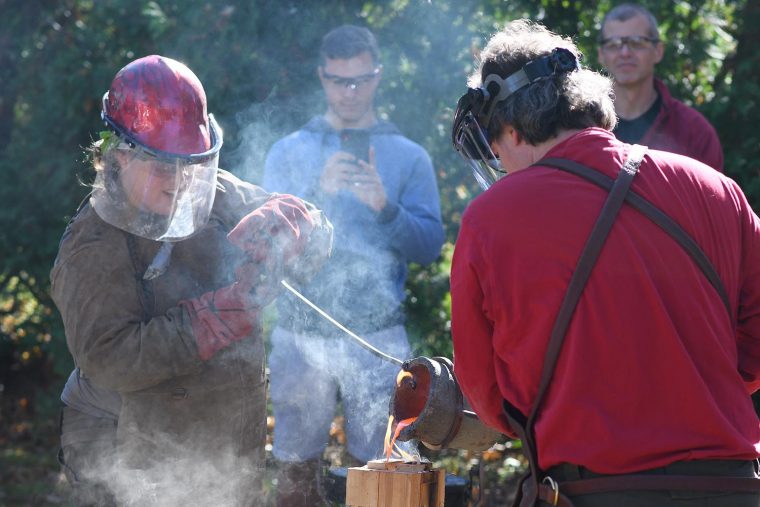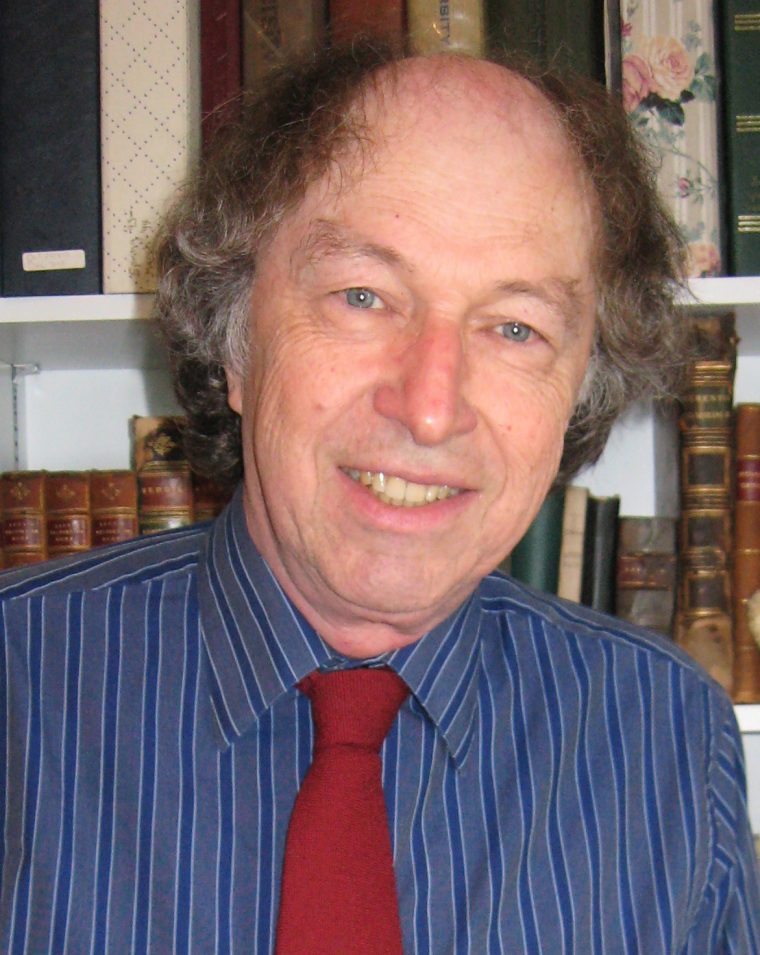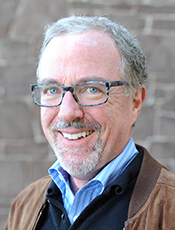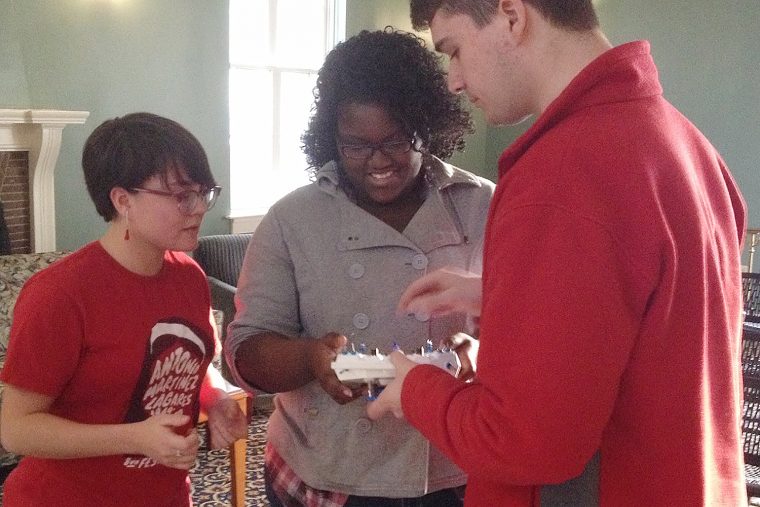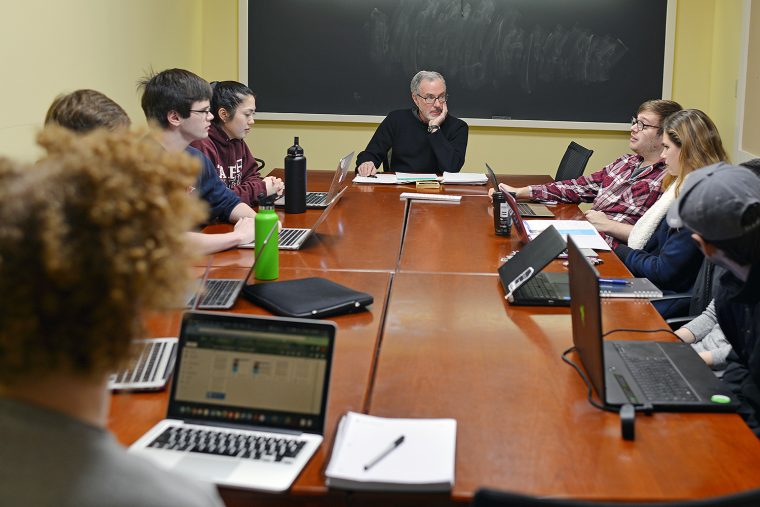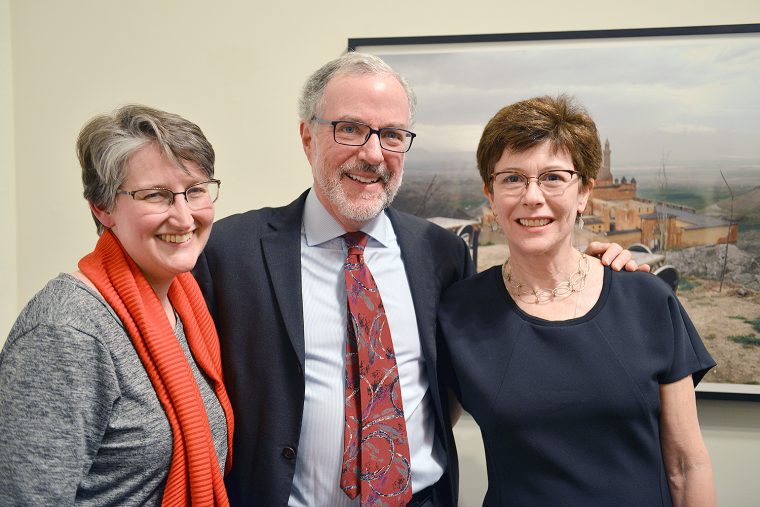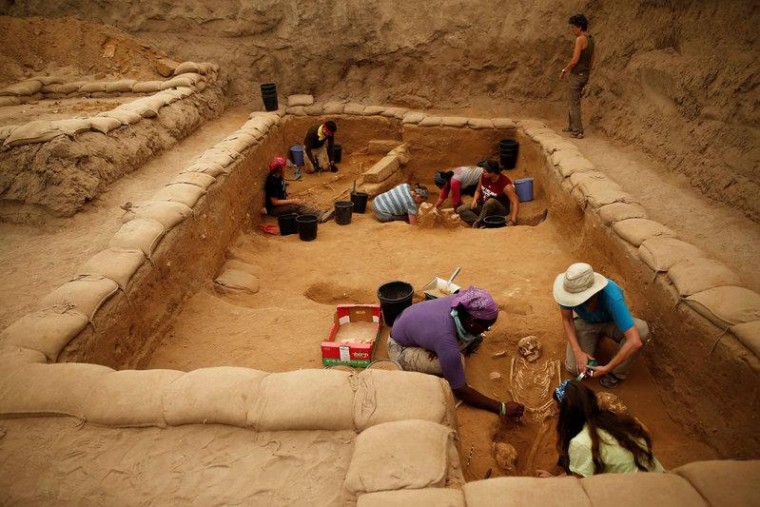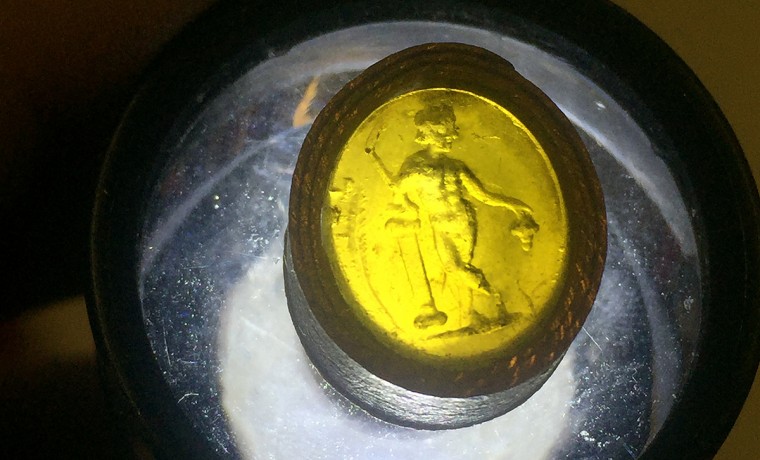There was something about Kate Birney's research that smelled a little off. As far back as the 4th century B.C., Greece was a global leader in producing a plethora of posh perfumes sold in handcrafted ceramic bottles marked with three chalky-white stripes. "Much like today, some of these ceramic perfume bottles were 'branded'—made in distinctive shapes, and painted or decorated in distinctive ways—probably to tell the consumer what scent they contained, or which perfume house/region they were imported from," said Birney, associate professor of classical studies and chair of Wesleyan's Archaeology Program. So when similar bottles, or unguentaria, were excavated…
Students taking the CCIV/ARCP 153: Single Combat in the Ancient World course learned how to cast their own bronze sword and arrowhead during class on Oct. 24. The process is a modern-day method of how weapons would have been crafted during the Late Bronze Age (3000 to 1200 BC). The two-hour workshop was taught by Connecticut bladesmiths Barbara Wechter of Wechter Arms and Matt Berry of Hopkins Forge. Berry is a former contestant on History Channel's "Forged in Fire." While Berry heated molten bronze (copper and tin) to 1,900 degrees Fahrenheit, Wechter demonstrated how to build a mold from oil-based…
Wesleyan faculty frequently publish articles based on their scholarship in The Conversation US, a nonprofit news organization with the tagline, “Academic rigor, journalistic flair.” In a new article, Elizabeth Bobrick, visiting scholar in classical studies and visiting assistant professor in liberal studies, writes about lessons from Sophocles' Greek tragedy Antigone, a play which, she writes, "mirrors the state of America's current disunion." What the Greek tragedy Antigone can teach us about the dangers of extremism In a Greek tragedy written in the middle of the fifth century B.C., three teenagers struggle with a question that could be asked now: What happens when…
During the Annual Meeting for the Society for Classical Studies, Michael Roberts, the Robert Rich Professor of Latin, Emeritus, served as a respondent in a session devoted to commemorating the 30th anniversary of the publication of his book, The Jeweled Style: Poetry and Poetics in Late Antiquity. The meeting took place in San Diego, Calif., Jan. 3–6, and included numerous paper and panel presentations; roundtable discussion sessions; performances by the Committee on Ancient and Modern Performance; meetings and receptions of affiliated groups; and more. In The Jeweled Style (1989), Roberts offers a new approach to the Latin poetry of late antiquity, one…
As an inaugural Onassis Foundation Teaching Fellow in Culture and Humanities, Andrew Szegedy-Maszak, the Jane A. Seney Professor of Greek, will have the opportunity to teach Greek history to incarcerated students through Wesleyan's Center for Prison Education (CPE). Starting during the spring 2019 semester, Szegedy-Maszak will teach an adapted version of his Wesleyan course CCIV 231: Greek History to men at the Cheshire Correctional Institution. "I was surprised and very honored when I heard that I was awarded the fellowship," said Szegedy-Maszak. "This class will be a survey of ancient Greek civilization over about 1,000 years, from the Bronze Age to the…
The scent of ancient perfumes evaporated eons ago, but scientists are able to reconstruct their ingredients by analysis of the residues left on their containers. Up until now, however, such studies have largely been isolated in the scientific literature, disconnected from the textual and archaeological data that place these perfumes back into the hands of their ancient users. Kate Birney, assistant professor of classical studies, archaeology, and art history, is hoping to change that as co-architect of the OpenARCHEM project, which seeks to assemble the largest set of organic residue samples ever collected from archaeological artifacts around the Mediterranean. Built…
On March 28, the Archaeology Program and the Department of Classical Studies invited Ian Roy of Brandeis University to Wesleyan to discuss ways new technologies are used to study the past. Roy is the founding head of Brandeis MakerLab and director for research technology and innovation at Brandeis University's library. Roy first visited the Archaeometry: How to Science the Heck out of Archaeology class taught by Andrew Koh, visiting assistant professor of archaeology. There, he demonstrated how to scan objects in 3-D using an Artec Space Spyder, a tool that uses structured light to capture incredibly high-resolution scans of objects. The class produced multiple models of artifacts, including a…
When President Michael Roth speaks about the purpose of college, he frequently boils it down to three key things: students should find what they love to do, get better at it, and learn to share what they love with others. This semester, Wesleyan is adding to its curriculum to help students develop this third critical skill. Wesleyan recently received a 3-1/2 year grant for over $600,000 to pilot on campus the Calderwood Seminars, which train students in translating complex arguments and professional jargon from their academic disciplines into writing that can be understood and appreciated by the general public. The seminars, developed by…
The Ancient Romans relied on a curious object to tell time: a sundial in the shape of an Italian ham. National Geographic has featured the work of Wesleyan's Christopher Parslow to re-create this ancient "pork clock" through 3-D printing, which is helping researchers to better understand how it was used and what information it conveyed. "It does represent a knowledge of how the sun works, and it can be used to tell time,” said Parslow, professor and chair of Classical studies, professor of archaeology, professor of art history. The small, portable prosciutto sundial —the "pocket watch of its day," according to the article—was…
Two Wesleyan students, one recent alumna and a faculty member contributed to a groundbreaking discovery of the first Philistine cemetery, a crowning achievement of more than 30 years of excavation in Ashkelon, Israel. Archaeologists and scholars have long searched for the origin of the Philistines, and the discovery of the cemetery is poised to offer the key to this mystery. Findings from the cemetery, dated to the 11th–8th centuries BCE, may well support the claim – long inferred and recorded in the Bible – that the Philistines were migrants to the shores of ancient Israel who arrived from lands to the…
During the Roman Empire, the art of gem carving or intaglio provided a way to characterize one's self, family or acquaintances. This summer, three Wesleyan students with an interest in classical studies worked with a Roman intaglio collection previously owned by J. Pierpont Morgan (father of J.P. Morgan) at the Wadsworth Atheneum Museum of Art in Hartford. As interns, Maria Ma '17, Margot Metz '18, and Emma Graham '19 collaborated on documenting and cataloging about 200 intaglio gems, which made the collection accessible to a wider audience of scholars and museum visitors. The gems were hidden from public view for decades. "It's so exciting that our students had the opportunity…



